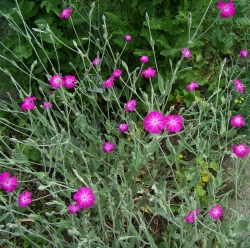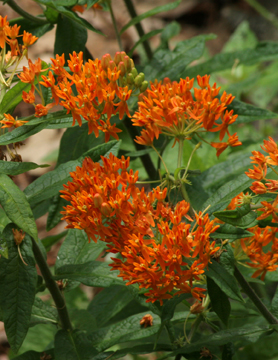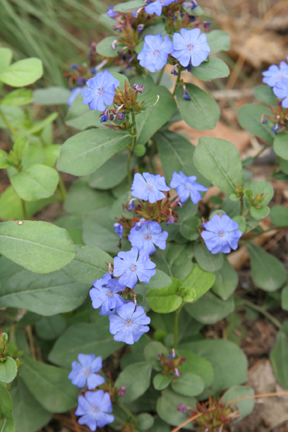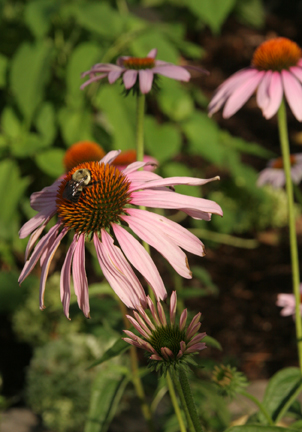By Steffie Littlefield
 Now it’s hot and dry just like every summer in St Louis and you look at your perennial border and a few sturdy souls stand out. You know the ones that don’t have wilted singed foliage, who still produce fresh flowers, whose color hasn’t faded to almost white or gray. Ever wonder why these can take the dry, warm weather while other plants seem to melt away? It’s all in the roots, at least mostly. Some perennials that adapt well to dryer growing conditions do so because they have deep roots that can find moisture in the greater depths of our soil. In fact these are sometimes harder to grow in a pot because they need the depth to accommodate their huge root systems.
Now it’s hot and dry just like every summer in St Louis and you look at your perennial border and a few sturdy souls stand out. You know the ones that don’t have wilted singed foliage, who still produce fresh flowers, whose color hasn’t faded to almost white or gray. Ever wonder why these can take the dry, warm weather while other plants seem to melt away? It’s all in the roots, at least mostly. Some perennials that adapt well to dryer growing conditions do so because they have deep roots that can find moisture in the greater depths of our soil. In fact these are sometimes harder to grow in a pot because they need the depth to accommodate their huge root systems.
Many of these plants are derived from prairie plants that evolved into long-rooted, drought tolerant varieties. But don’t think that just because they have a native plant heritage, that there will be no maintenance. Any new planting that is starting from plants grown in a pot will require regular watering to get established until the roots have the opportunity to stretch way down below. Excess water on the other hand can cause yellowing leaves, fungus spots and an over abundance of top growth that is hard to maintain in dry months.
Here are some of my favorites for the dry garden:
- Artemisia ‘Silver King’, great silver foliage plant, best kept dry to keep its’ invasive habit under control.

Asclepias tuberosa - Butterfly Milkweed
- Asclepias tuberosa, butterfly weed has wonderful orange flowers that will rebloom if cut back, a nice prairie plant that is essential for a wildlife garden.
- Baptisia australis, lovely blue flowers early in the season followed by wonderful bluish foliage that forms a shrub-like plant that looks great all summer. Plant this where you want it, because you can never move it, its roots go so deep.
- Centaura montana, Another early-season blue bloomer, seeds itself, blooms for months and then maintains nice fuzzy leaves with a gray shading.

Ceratostigma plumbaginoides - Hardy Plumbago
- Ceratostigma plumbaginoides, (hardy plumbago) another marvelous blue flowering plant with an added bonus of bright red fall color.
- Dianthus, especially love the blue/gray grass-like foliage and bright red or pink flowers.

Echinacea purpurea - Pink Coneflower
- Echinacea purpurea, pink coneflower, a native prairie plant that belongs in every garden.
- Echinops, with its spiky flower heads and silvery blue color is hard to beat in the dry cutting garden.
- Epimedium, an underused sturdy little plant that spreads like a groundcover. Has mini-orchid like flowers and heart-shaped leaves on wiry stems. Does well in dry shade.
- Geranium sanguineum, (cranesbill) charming little purple flowers, low and spreading.
- Lychnis coronaria, another butterfly attractor, blooms in early summer.
- Penstemon ‘Huskers Red’, wonderful dark reddish foliage.
- Perovskia (Russian sage), the miracle plant that just keeps looking good in the worst part of the summer. Its only drawback is floppy tendencies, just plant a sturdy neighbor plant and solve your staking problem.
- Solidago (Goldenrod), Wow that’s really yellow. A great native prairie plant used to make fabric dyes.
Combining these plants for a dry garden bed will save water and labor once the plants are established enough to survive that August drought. Remember all new plantings need to be watered enough to keep the plants thriving while they grow deep roots.
Steffie Littlefield is a horticulturist and garden designer at Garden Heights Nursery. She has degrees from St Louis Community College at Meramec and Southeast Missouri State University and is a member of the Gateway Professional Horticulturist Association (GPHA) and past president of the Horticulture Co-op of Metro St Louis.
